
Alliaria petiolata, or garlic mustard, is a biennial flowering plant in the mustard family (Brassicaceae). It is native to Europe, western and central Asia, north-western Africa, Morocco, Iberia and the British Isles, north to northern Scandinavia, and east to northern Pakistan and Xinjiang in western China.

Luina, commonly called silverback, is a small genus of perennial shrubs in the groundsel tribe within the sunflower family.

Claytonia virginica, the Virginia springbeauty, eastern spring beauty, grass-flower or fairy spud, is an herbaceous perennial plant in the family Montiaceae. Its native range is eastern North America. Its scientific name honors Colonial Virginian botanist John Clayton (1694–1773).

Fraxinus albicans, commonly called the Texas ash, is a species of tree in the olive family (Oleaceae). It is native to North America, where it is found from eastern Texas and southern Oklahoma in the United States, to the state of Durango in Mexico. Its natural habitat is in dry, rocky slopes, often over limestone.

Aesculus californica, commonly known as the California buckeye or California horse-chestnut, is a species of buckeye native to California and southwestern Oregon.
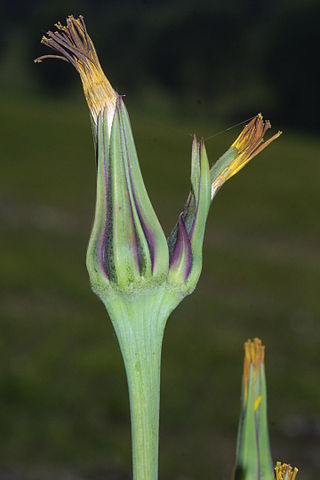
Tragopogon pratensis is a biennial plant in the family Asteraceae, distributed across Europe and North America, commonly growing in fields and on roadsides. It is found in North America from southern Ontario to Massachusetts; most of England; on the eastern and southern edges of Scotland; and central Ireland but not the coastal edges.

Lysimachia borealis, the starflower, is a North American woodland perennial that blooms between May and June.

Krascheninnikovia lanata is a species of flowering plant in the family Amaranthaceae, known by the common name winterfat. It is native to much of western North America: from central Western Canada; through the Western United States; to northern Mexico.

Spiranthes cernua, commonly called nodding lady's tresses, or nodding ladies' tresses, is a species of orchid occurring from Maritime Canada to the eastern and southern United States. As the common name suggests cernua means "nodding", or "bowed" in Latin.

Rainiera is a monotypic genus of flowering plants in the daisy family, Asteraceae. The single species, Rainiera stricta(Greene) Greene, is endemic to the northwestern United States. The genus is part of the tribe Senecioneae, and appears to be most closely related to Luina, another genus of northwestern North America, in which it was once placed. Rainiera stricta is of conservation concern, with a G2G3 ranking from NatureServe, and is considered to be globally imperiled. It is known by the common name false silverback.

Rafinesquia neomexicana is a species of flowering plant in the family Asteraceae. Common names include desert chicory, plumeseed, or New Mexico plumeseed. It has white showy flowers, milky sap, and weak, zigzag stems, that may grow up through other shrubs for support. It is an annual plant found in dry climate areas of the southwestern deserts of the US and northwestern deserts of Mexico.

Monardella hypoleuca is a species of flowering plant in the mint family, known by the common names thickleaf monardella and white leaf monardella.

Rhus aromatica, the fragrant sumac, is a deciduous shrub in the family Anacardiaceae native to North America. It is found in southern Canada and nearly all of the lower 48 states except peninsular Florida.
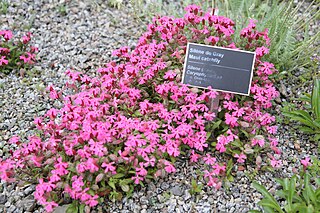
Silene grayi is a species of flowering plant in the family Caryophyllaceae known by the common name Gray's catchfly. It is native to the mountains of Oregon and northern California, including the Klamath Mountains, where it grows in chaparral, mountain forests, and the talus of high slopes in alpine climates. It has been observed to occur in a plant association with oceanspray, littleleaf silverback, and Gray's bedstraw. It is a perennial herb producing a decumbent or erect stem up to 20 or 30 centimeters long from a woody, branching caudex. The base of the plant is covered in tufts of leaves. These basal leaves are lance-shaped to nearly spoon-shaped, fleshy, and up to 4 centimeters long. Smaller, narrower leaves occur farther up the stems. Each flower has a tubular calyx of fused sepals lined with ten green or red veins and covered in glandular hairs. It is open at the tip, revealing five pink or purple petals. The petal tips and appendages are divided into narrow lobes.
Sedum moraniii is a rare species of flowering plant in the family Crassulaceae known by the common name Rogue River stonecrop. It is endemic to Oregon in the United States, where it only grows in Josephine County next to the Rogue River.
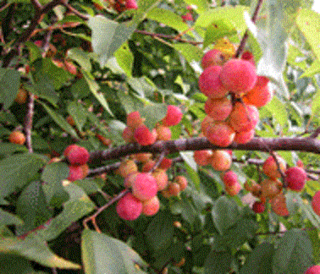
Prunus rivularis, known variously by the common names creek plum, hog plum, or wild-goose plum is a thicket-forming shrub. It prefers calcareous clay soil or limestone-based woodland soils. This deciduous plant belongs to the rose family, Rosaceae, and is found mainly in the central United States. It is a shrub consisting of slender stems with umbel clusters of white blossoms. The fruit is a drupe that resembles a large berry; though it has a bitter taste, it serves as a source of food for birds and other wildlife. "Prunus" is Latin for plum, whereas "rivularis" means being near a stream.
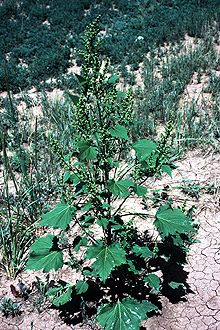
Cyclachaena xanthiifolia, known as giant sumpweed, or rag sumpweed is a North American plant species in the sunflower family, Asteraceae. It is the only species in the genus Cyclachaena. Giant sumpweed is believed to be native to the Great Plains but is now found across much of southern Canada and the contiguous United States, though rarely in the Southeast.
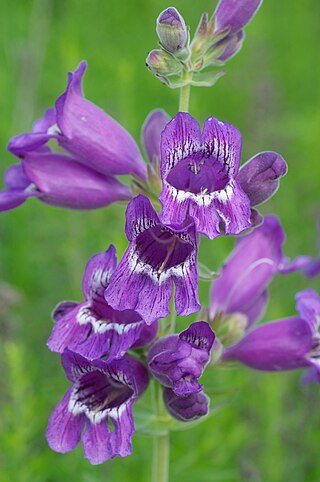
Penstemon cobaea is a flowering plant in the plantain family, commonly known as cobaea beardtongue, prairie beardtongue or foxglove penstemon. The plant is native to the central United States, primarily the Great Plains from Nebraska to Texas, with additional populations in the Ozarks of Missouri and Arkansas. There are also populations reported in the southwestern United States as well as in Illinois and Ohio, but these appear to be introductions.

Liatris ligulistylis is a flowering plant of the family Asteraceae, native to the central United States and central Canada.
Hypericum galioides, the bedstraw St. Johnswort, is a species of flowering plant in the St. John's wort family, Hypericaceae. It is endemic to the Southeastern United States.




















